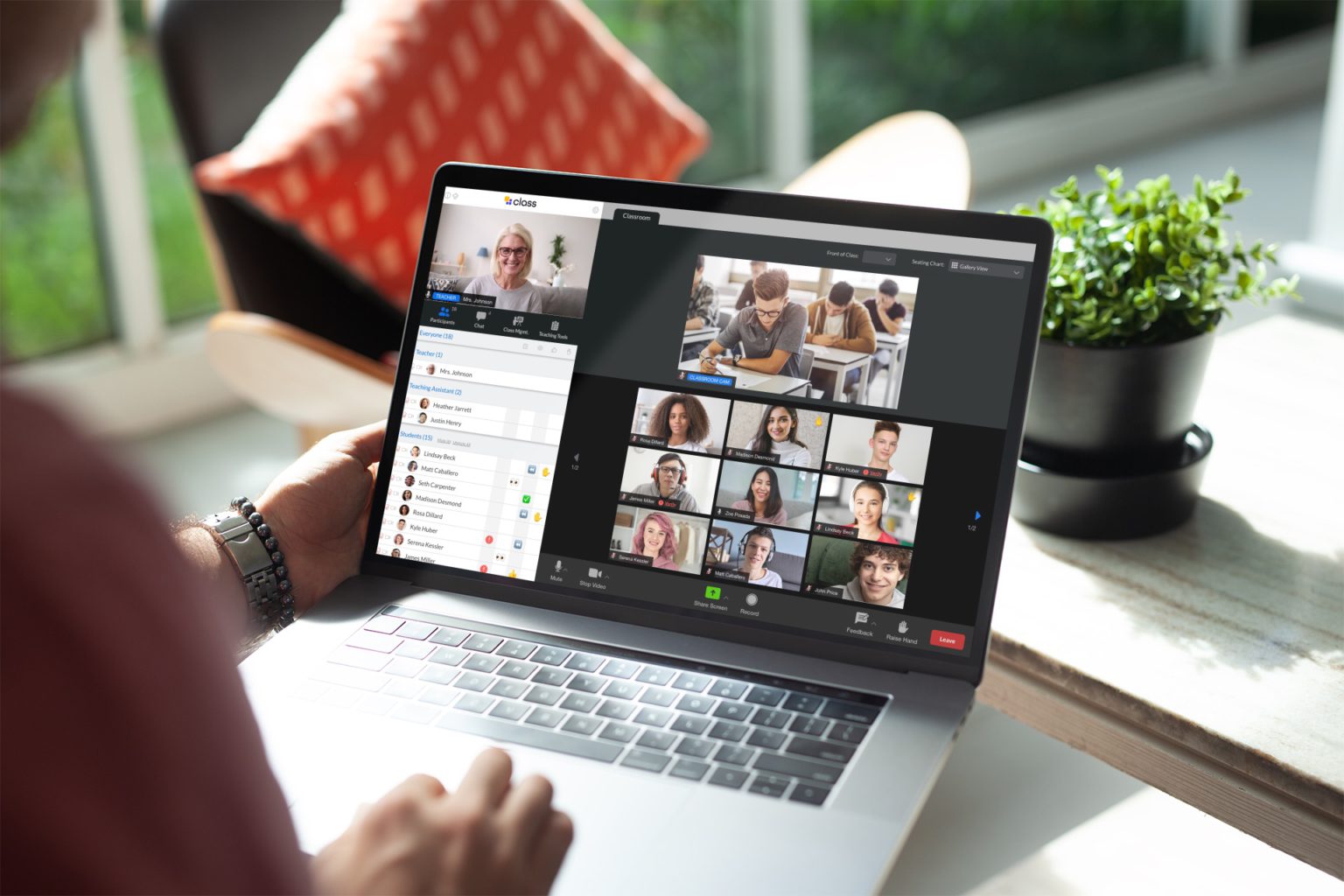
Class is the next generation virtual classroom for K-12, higher education, government agencies, and the workplace. Contact us today to schedule your live demo and see Class in action.

Class is the next generation virtual classroom for K-12, higher education, government agencies, and the workplace. Contact us today to schedule your live demo and see Class in action.

As we approach almost one year since classrooms around the country at all levels had to suddenly adjust to new methods of instruction, many are becoming all too familiar with a new way of teaching and learning: hybrid teachings and hybrid classrooms.
Hybrid teaching and classrooms, as the names suggest, are not all in-person or entirely remote. Instead, they reflect a combination—or hybrid—of the two settings. In some hybrid classrooms, students all come to the physical classroom a few days a week and learn remotely on the other days. In other cases, some percentage of the students are in the classroom and others are remote—all learning at the same time.
Karen Gross is an author and educator, former college president and former senior policy advisor to the US Department of Education under the Obama administration. “The hybrid structure is not uniform,” Gross notes. “In some instances, the in-person classes run simultaneously with online classes. And, for those that are structured such that students are in schools some days and online other days, there are some similar but added differences.” Class can be used to easily traverse any of these hybrid teaching scenarios, allowing teachers the opportunity to set up their classes and their activities and interactions in ways that work best for their class format.
It’s not hard to imagine that these sudden shifts, along with the uncertainty of the situation, led to consternation and concerns on the part of students, teachers, parents, and administrators. Fortunately, options have emerged to help everyone successfully navigate these new online teaching and classroom formats. Class Technologies is one notable example.
Class has built on, and improved, the already popular Zoom platform used for business meetings, to make it a go-to resource for educators. It offers functionality that meets the needs of instructors and helps them leverage technology in new and creative ways.
Hybrid learning has not been a smooth transition for everyone. Garrett Smiley, co-founder of Sora, an all-virtual high school, says “a significant percentage of this country’s students are being left behind by this rapid shift to online or hybrid learning.” But he says there are some best practices that he has found to help improve the odds that the transition to hybrid teaching and classrooms will go smoothly.
At Sora, he says, one-on-one sessions between teachers and students have been a great way to clearly communicate expectations and processes in the online learning environment. “Even setting aside the whole first week to just rotate through one-on-one meetings with each student would still be a wise investment of time,” he says.
Class makes this easy to do, offering teachers and students opportunities for interactions that closely approximate the real-world school setting. And, with student permission, these interactions can be recorded so teachers can refer back to them later.

In hybrid learning settings, it’s important for students to have opportunities to engage with each other as well as with their instructors. Smiley suggests arranging interactions between students and the rest of their classmates. Class makes it easy for everyone to participate via video and to share information via screen share. “At Sora, our students have a morning homeroom, that we call ‘stand up,’ where they turn their camera on and present their daily goals and responsibilities to their classmates,” he says.
Other forms of interactions like this can be readily managed through Class, whether one-on-one or in small groups. Groups can be pre-assigned or assigned randomly during class time. Teachers can easily “pop in” to engage with students as they’re participating in groups and easily call them back together into one large classroom.
Since hybrid teaching has been new for most now involved in these models, there are bound to be some hiccups along the way. These are to be expected, says Gross.
“Moving from in-class to online to in-class is tough sledding, even for the most stable educator,” Gross acknowledges. “The pedagogical approaches differ. It is easy to get lost in the minutia. That is why we need to have some allowances here for things not working, for people to make mistakes, for there to be efforts that are not ideally executed including due to technological challenges.” Her “mantras for the moment:” Be kind. Be thoughtful. Be open. Be creative.
While Class provides an exceptional environment for hybrid teaching and learning, students and teachers are all participating from different locations with different connection speeds, different levels of access and different equipment.
The unexpected will happen. When it does, Class can help you be prepared for it.

Teachers in traditional classroom settings have long relied on guest speakers, student teachers, teaching assistants and others to help with their classes. They can continue to rely on others in the hybrid environment, often while offering more convenience for those participating.
Michelle Cirillo is an associate professor in the Department of Mathematical Sciences at the University of Delaware. She was doing field research on student teachers in math education when COVID forced a switch to online learning. When classes went online, student teachers were able to become a valuable part of the new environment, being able to take part in small breakout Zoom groups where they could work with young students and answer questions. Because the Zoom breakouts were recorded, it gave student teachers a chance to review and reflect on their interactions with students, while providing instructors a tool for providing feedback to student teachers.
Many of the lessons and best practices that teachers and students are gaining during virtual learning involve offering potential new ways of doing things even once in-person learning has returned. For instance, online office hours, which offer both teachers and students the flexibility of connecting whenever and wherever they are. Hybrid learning can also be a way to address issues related to climate concerns. Children in the northern part of the country may never see another “snow day” again—something both they and their parents may lament.
In any event, chances are that hybrid teaching and learning will remain an option even long after safety concerns have passed. “I hope schools lean into online learning resources so teachers can be free to create engaging, active learning opportunities for their students,” says Smiley. When they do, they can turn to Class to help them provide an experience that’s almost like being together in the classroom.

Class is the next generation virtual classroom for K-12, higher education, government agencies, and the workplace. Contact us today to schedule your live demo and see Class in action.

Class is the next generation virtual classroom for K-12, higher education, government agencies, and the workplace. Contact us today to schedule your live demo and see Class in action.
Get our insights, tips, and best practices delivered to your inbox

Sign up for a product demo today to learn how Class’s virtual classroom powers digital transformation at your organization.

Features
Products
Integrations